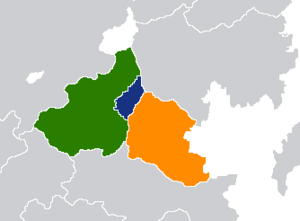Hacyinian-Lavanan wars and conflicts
Since the Partition of Southeast Coius in 1941, which created the Republic of Lavana. Hacyinia and Lavana have been involved in a number of wars, conflicts, and military standoffs. A long-running dispute over the borders of both states, along with historical, ethnical, and religious claims to territory have led to conflict. Initially the conflict revolved around land claims by both countries following the creation of Lavana, termed the Galshir Conflict. The establishment of the modern borders in 1961 following the Third Galshir Conflict (1961-1963), gave way to State-sponsored terrorism and support for religious, nationalist, secessionist, political groups in each country by the other. In 1992, Lavana invaded Hacyinia and established the secessionist People's Republic of The Yoloten in the conquered territory.
Background
The Partition of Southeast Coius saw the partition of Estmerish controlled Southeast Coius into two states Lavana and Dezevau. Hacyinia held large land claims to territory in the Estmerish possession, based on ethnical as well as religious basis. Although not directly under Estmerish control and influence, numerous Princely states located on the border between Estmerish controlled territory and Hacyinia were coerced to join Lavana rather than Hacyinia, with numerous rulers which on paper were granted the choice of joining Lavana, Dezevau, or Hacyinia being forced to join Lavana. Numerous rulers as well opted to join Lavana willingly despite stark desires in their population. Hacyinia which had reached several agreements with Estmere following the transfer of former Gaullican administration of the region to Estmere following the Great War, had expected the transfer of territory from Estmere and the joining of several princely states with the nation.
Estmere sought to placate the nationalistic Confederation of Free Lavana (CFL) by creating a majority Kachai state, along with reducing the power and influence of Dezevau, which was on the verge of becoming a full blown Councillist state. Lavana was favored by Estmere as the primary democratic anti-councillist state, in Estmerish attempts to curtail socialist power in the region as much as possible. When the decision to partition the territory came to be, Estmere favored the establishment of a strong Kachai anti-socialist state over the creation of a separate Oroqic state as was desired by republican nationalist Oroqics, or giving land to Hacyinia.
Wars
First Galshir Conflict (1941)
Upon partition, Hacyinian forces protested the expected partition of Estmerish territory demanding that land inhabited by majority Oroqic populations be turned over to Hacyinia. Numerous princely states in the region of Galshir with large Oroqic populations and friendly !Kings, as well were coerced heavily by both Estmere and Lavana to join Lavana. Lavana initially prepared for conflict with Dezevau, as both countries struggled to deal with the large migrations occurring. Hacyinia decided to establish its own borders and bring friendly princely states into the country. The Princely state of the Yoloten was the largest of all princely states and held a majority of Oroqic populations along with a large Irfanic population, however the state was controlled by a Badist Kachai !King, who desired joining Lavana. Hacyinia armed and provided support to rebels in the Yoloten.
On October 21st, mere weeks after independence Lavana recognized a state of war between Lavana and Hacyinia, after Hacyinian forces were welcomed by friendly !Kings. Hacyinia proceeded to invade the Yoloten, Galshir, and Terjasa. Large sections of Lavana were occupied by Hacyinia, which declared this to be the natural borders of its state. Lavana which was on the verge of conflict with Dezevau, along with internal infighting in the government, agreed to a Community of Nations brokered ceasefire at the end of the 22nd of December 1941. Hacyinia claims the 1941 borders to this day, which it formally incorporated into its nation.
